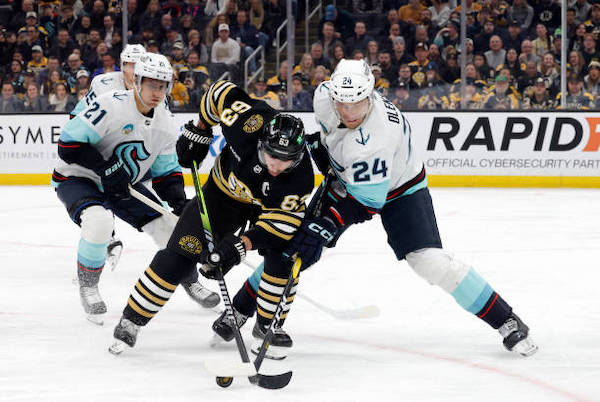
By: Jason Cooke | Follow me on Twitter / X @cookejournalism
The Boston Bruins have limped out of the National Hockey League All-Star break. Since returning to play against the Calgary Flames on February 6th, the Bruins have skidded through a 1-3-1 stretch while on a seven-game homestand at TD Garden. Not only have the Bruins lost four of their last five games, but the B’s have been playing their worst hockey of the season.
They’ve been slow and unresponsive, looking like a team that wasn’t returning from the hiatus tied for first place in the NHL. While many aspects of their game can be to blame, the power play–which has gone 1-19 over that span—has been a glaring issue for the Black and Gold. The Bruins still hold up as the eighth-best power play team in the league at 23.7 percent, but they are looking far from a top-10 standard as of late. Let’s take a look as to why that may be:
Before we can analyze what’s been going wrong in-zone on the man advantage, we must first look at Boston’s struggle to enter the offensive zone. Across the NHL, penalty kills are shifting to be more passive in the neutral zone, utilizing a one-three-one formation to build a wall on the blue line. If done correctly, it is much harder for a clean break-in because the entire blue line is occupied with defenders. The Tampa Bay Lightning executed this strategy to perfection.
The Lightning positioned one attacker in the middle, in this case, Luke Glendening, to steer the Bruins to one side on the zone entry. Once David Pastrnak passed it off to a streaking Pavel Zacha, he was met with two Lightning defenders who made a play to break it up. So the Bruins regrouped, as Pastrnak entered the zone with speed only to face more pressure from Tampa Bay’s line of defense. When a pass to James van Riemsdyk was off the mark, the Bruins had already wasted substantial power play time trying to set up their unit. Eventually, Charlie McAvoy decides to flip the puck in the corner for the Bruins to attack.
When the Bruins are struggling on the power play, they need to simplify all aspects of their game plan, and that means getting pucks in deep when a clean entry isn’t in the cards. Boston was 0-6 on the man advantage in that matchup with the Lightning, whiffing on critical opportunities to tie the game and take the lead on the power play.
Once the Bruins can get in the zone, they haven’t been able to generate meaningful scoring opportunities in high-danger zones. Let’s break down one of Boston’s four unsuccessful attempts against the Washington Capitals last Saturday. After the Bruins (barely) get it in the zone, they produce a lengthy offensive zone shift on the advantage. But the Bruins simply weren’t a threat to score.
The Bruins look to position Pastrnak and Brad Marchand on their strong sides, opening the door for one-timer opportunities and catch-and-shoot chances coming downhill with speed. To open up those windows, the Bruins need to move the puck quickly, shuffling it from low to high and high to low. This forces the penalty kill to start moving around, opening passing lanes and creating more space for the Bruins to shoot.
In this instance, the Bruins didn’t really do that. Sure, they had Pastrnak and Marchand in their ideal spots with the puck on their sticks ready to shoot, but there were Washington shin pads directly in front of them, and the Washington goaltender wasn’t under any duress due to the lack of rapid puck movement. The shots that resulted in this power play were low-percentage chances from the perimeter. Once again, this opportunity to net the equalizer with the extra skater came at an important time of the contest. The Bruins failed to capitalize.
That’s not to say the Bruins haven’t created any good looks amidst their 1-19 run. In their loss to the Seattle Kraken on Thursday, the Bruins went 0-2 on the power play, but they filtered in some good looks. The best way to open up chances for Boston’s best shooters—Pastrnak and Marchand—is to correctly utilize the bumper. In this case, Morgan Geekie.
The Bruins began this chance overloading on the right side, sliding the puck to an open McAvoy on the blue line, who immediately finds Geekie on the bumper. Geekie one touches the pass to Pastrnak, rifling a cross-ice feed to Marchand. This sequence is exactly what the Bruins are looking for on the power play. The initial overload pulls the Kraken defenders to one side of the ice, opening up Geekie in the middle.
When Geekie receives that pass, he has all the options in the world. He could turn around and shoot, drop it back to Marchand, or, in this instance, give a quick touch pass to Pastrnak, resulting in a wide-open lane for Marchand on the right flank. If Marchand hadn’t whiffed on the pass, it would have been in the back of the net. This type of puck movement is the kind that forces the defense to run around, opening up chances all over the ice. The Bruins need to find this more.
The Bruins have the tools to turn around their recent power play struggles, and they’ve demonstrated their ability to be one of the top power play teams in the league. In rough patches like this, it’s all about simplifying their approach. Enter the zone clean, set up the formation, and work the puck around the perimeter to create the shots they want. Special teams are often the difference in contested games, so the Black and Gold will need to iron out their power play if they intend to make a run in the playoffs come spring.


Leave a Reply